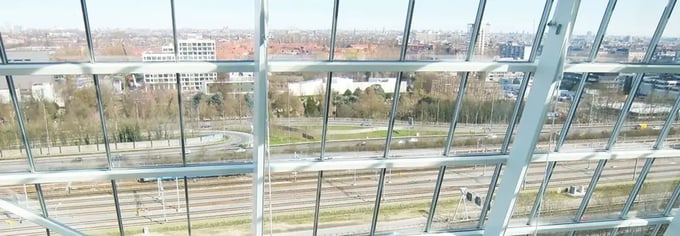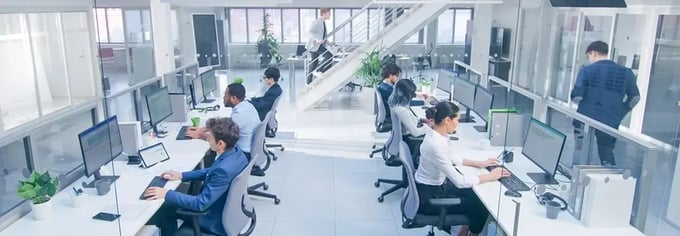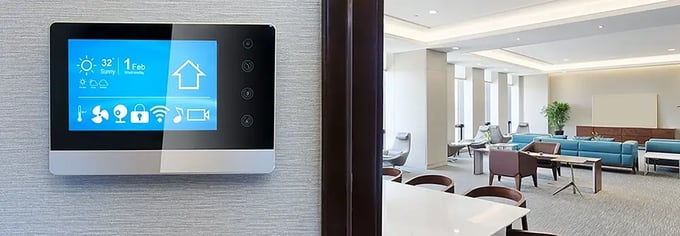Smart buildings have been a popular topic for over 40 years. But being able to use the Internet of Things (IoT) to connect all the systems in a single building is a much more recent development.
What does a fully automated smart building look like, and how can it inform and inspire builders and investors in smart building technology? We’re going to take a closer look at one of the world’s most lauded smart office buildings: The Edge. We cover:
- Why The Edge is considered a pinnacle of smart building design.
- The technologies it uses.
- How it can inform your own smart building ventures.
What is The Edge?
The Edge is a 40,000m2, 15-storey office building in the financial district of Zuidas in Amsterdam. Completed in 2015, The Edge has been repeatedly touted as the “smartest” and most sustainable office building in the world. The Building Research Establishment, the United Kingdom’s leading building science laboratory, gave it the highest rating in the world through its globally-acclaimed BREEAM sustainability certification.
It is owned and managed by Deloitte and was designed by London-based architecture studio PLP Architecture. It was commissioned to bring all of Deloitte’s staff in Amsterdam into one building that was perfectly suited for the company’s needs.

What makes The Edge the height of smart building design?
The Edge is a remarkable example of what can be done when sustainability is put at the heart design and operation of a commercial building.
Building orientation
The Edge has been built from the ground up to take advantage of both the latest in IoT and automation technology, but also the environment around the building itself.
The Edge has been built and shaped to take maximum advantage of the sun throughout the year. For example, the windows give the office the best use of daylight while an integrated, 6,000m2 solar array on its south face keeps excess solar radiation from entering the building while also providing for all its energy needs.
It is also built over a groundwater aquifer that the building draws from with thermal energy storage pumps that manage warm and cold water while using IoT sensors that can track both water usage as well as local climate conditions.

Only the most sustainable building materials & fixtures
The Edge is a testament to the possibility that, with appropriate planning and resources, it’s possible to construct an office building with a tiny ecological footprint. This extends to all kinds of materials and devices used throughout. For example:
- The entire building uses low-emission LED lights, 6,500 of them. At the time of its completion, The Edge was one of the first buildings to use this kind of lighting. When coupled with sensors that monitor lighting conditions and space occupancy, the result is lighting that uses the least possible energy, saving the building upwards of US$100K a year in energy costs.
- The building uses relocatable walls on 14 of its 15 floors that not only give users the power to rearrange workspace to fit their needs, but the walls themselves meet the highest BREEAM requirements for being durable and responsibly sourced, as well as meeting strict requirements for acoustic performance.
- Flooring is made from rapidly renewable and recycled concrete.

A workplace integrated with the Internet of Things
The Edge boasts nearly 30,000 IoT sensors, all collecting anonymous data about just about everything going on inside: This includes the building’s heating and cooling systems, lighting, room occupancy, printers, and even coffee machines.
Additionally, the entire IoT network uses machine learning algorithms that are focused on optimizing not only for energy consumption and performance but also for user comfort and productivity. The building uses only about 30% of the energy of a conventional office building of the same size. The network measures and manages a range of things that affect people’s comfort in the space: lighting, temperature, C02 levels, and humidity.
The Edge also employs an app as part of its IoT network: through their phones, workers can find parking spaces, open desks, report issues to facilities management, and see their own energy consumption while within the building.
What lessons can The Edge teach us when thinking about smart buildings?
There is enormous room for growth for smart buildings
The Edge has some impressive performance figures regarding efficiency, cost-saving, and its ecological footprint – but while it can be seen as the pinnacle of IoT-integrated design, it demonstrates a massive space for improvement between itself and conventional office buildings.
Even a building that could achieve just a few of the sustainability targets that The Edge has achieved would be a significant advancement for the way we build and use offices. You need only start with other projects completed by The Edge’s designers, PLP, for other examples of possible sustainable and IoT-integrated office spaces around the world.
Smart buildings pay dividends over time
There is already research showing the cost-benefit ratio of smart vs. conventional buildings. While The Edge demonstrates enormous cost savings over time compared to conventional buildings, most analyses of smart buildings show less but still significant cost savings.
From what we can find, there are indications that over time, a smart building can cost anywhere from around a third to half compared to a conventional building of a similar size. It should be noted that this there is a higher cost initially, so the savings do take time to set in.
Additionally, it’s been shown that even the inclusion of a few smart systems within a commercial building can deliver significant boosts to efficiency. However, the best results are acheived by integrating multiple smart building solutions.
A successful smart building means more than just conserving resources
A smart building is just as much about learning and adapting to the way people use buildings, and how that is changing over time as it is about energy efficiency and sensor integration.
One of the notable features of The Edge’s design is it is built around the discovery that many of Deloitte’s staff only needed a desk for roughly a third of their working day. In response, the building only provides desk space for 1,100 people, which serves their staff of 3,000.
It logically follows that because the cost of labor is almost invariably higher than the cost of space and office infrastructure, spending on high-quality space that supports people’s well-being and productivity is a smart way to save costs and retain talent for your organization. Smart building technology is perfectly positioned to make this easy and deliver results almost right away.
Learn more about how smart buildings can help you
Exploring the possibilities of smart buildings? Want to find out what you need to know to make informed design or investment decisions? We're building a library of content about smart technology and the Internet of Things. We’ve recently highlighted six technologies we think anyone that’s interested in smart buildings should know about – learn more here.